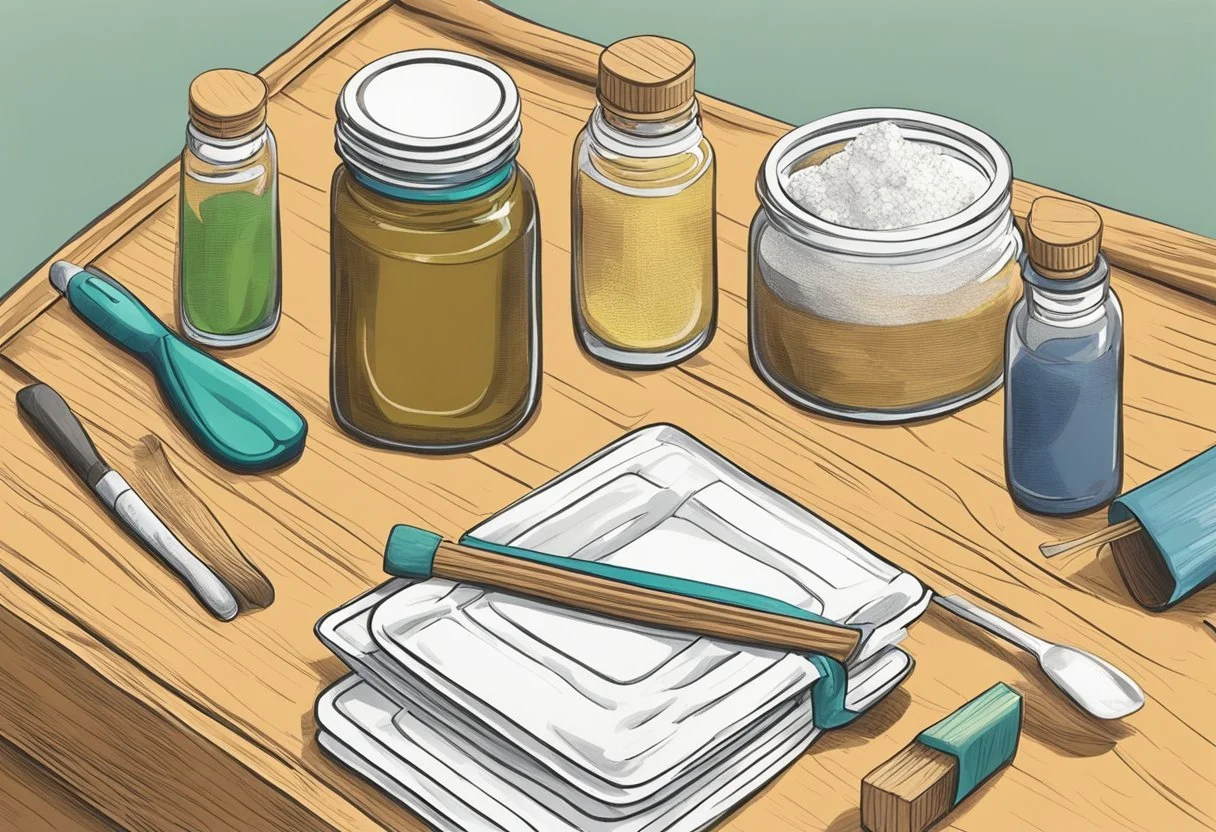DIY Chest Rubs for Congestion
Effective Homemade Solutions
This article is part of our series on Natural Health
Discover > Natural Health > DIY Chest Rubs for Congestion
Chest congestion can be a troublesome issue, particularly during cold and flu season. The path to relief often involves purchasing expensive over-the-counter medications, which might not always be ideal. For those seeking a more accessible and natural approach, DIY chest rubs provide a noteworthy alternative.
Homemade chest rubs can be concocted with common ingredients found in most kitchens and offer a cost-effective way to alleviate congestion. The benefits of these DIY rubs are manifold, ranging from soothing irritated skin to loosening mucus. In this article, we will explore the various ingredients used in making these remedies and discuss the most effective techniques for utilizing them.
Experimenting with different blends and applications can help individuals discover the most suitable solution for their specific needs. Not only can these DIY chest rubs provide relief from congestion, but they also foster a sense of accomplishment and self-sufficiency. So, let's delve into the world of homemade chest rubs and learn how to make congestion a thing of the past.
Understanding Congestion
Congestion is a common symptom experienced during colds, coughs, and other respiratory issues. It occurs when the nasal passages and sinuses become inflamed and produce excess mucus. This can be caused by various factors, such as the common cold virus, bacteria, or allergens.
The common cold is a viral infection that affects the upper respiratory tract, causing symptoms such as congestion, runny nose, and coughing. When the cold virus enters the body, it triggers an immune response, leading to inflammation of the nasal passages and sinuses. This inflammation causes the production of mucus, which can obstruct the airways and make it difficult to breathe.
Mucus is a natural protective substance produced by the body to trap and remove foreign particles, bacteria, and viruses. In normal circumstances, it helps maintain the health of the respiratory system. However, when excess mucus is produced due to congestion, it can become an issue. The thickened mucus can block the airways and make it difficult for the person to breathe comfortably.
The bacteria present in the respiratory system can also contribute to congestion. When the nasal passages and sinuses are inflamed, they can become more susceptible to bacterial infection, which can further exacerbate the congestion. In some cases, the congestion can progress to sinusitis or other respiratory complications if left untreated.
An expectorant is a type of medication that helps thin and loosen the mucus, making it easier for the affected individual to expel it through coughing. The use of expectorants can be beneficial in managing congestion and alleviating the symptoms associated with respiratory issues.
In conclusion, congestion is a common issue faced by individuals dealing with colds, coughs, and other respiratory problems. It is primarily caused by the inflammation of the nasal passages and sinuses, leading to excess mucus production. Understanding the causes and factors contributing to congestion can help in managing its symptoms effectively.
The Importance of Essential Oils
Essential oils play a crucial role in DIY chest rubs for congestion relief. These oils are natural extracts from plants, such as lavender, eucalyptus, peppermint, frankincense, tea tree, and rosemary. The aroma released by these oils is beneficial for alleviating congestion and improving breathing.
Eucalyptus essential oil is known for its powerful decongestant properties, making it an effective component in chest rubs. It works by opening up the airways, which assists in reducing inflammation and swelling.
Peppermint essential oil contains menthol, a natural compound that provides a cooling sensation. When applied to the chest, it helps soothe the throat and facilitates in clearing congestion.
Lavender essential oil is widely recognized for its relaxing and calming effects. Incorporated in a chest rub, it aids in relieving nasal congestion while promoting a sense of relaxation and restful sleep.
Tea tree essential oil holds strong antifungal and antiviral properties. This makes it a valuable addition to DIY chest rubs as it helps in fighting infections, reducing inflammation, and clearing mucus.
The therapeutic properties of these essential oils provide a natural and safe way to alleviate congestion. While they are not a substitute for medical treatments or prescribed medications, they can serve as a complementary therapy to enhance the relief process. It is essential to use high-quality, pure essential oils to ensure their effectiveness and safety when used in chest rubs.
DIY Chest Rubs for Congestion Relief
Dealing with respiratory health issues can be challenging, especially during the cold and flu season. A popular remedy to alleviate congestion is by using a chest rub. While commercial vapor rubs are available, creating a homemade chest rub using essential oils is a natural and more cost-effective option. This brief guide will cover a DIY recipe for creating your own chest rub at home.
Ingredients:
Eucalyptus essential oil
Peppermint essential oil
Lavender essential oil
Carrier oil (such as coconut oil or olive oil)
To create a DIY vapor rub, begin by mixing the following amounts of essential oils in a small container:
10 drops eucalyptus essential oil
5 drops peppermint essential oil
5 drops lavender essential oil
These essential oils are known for their respiratory health benefits. Eucalyptus oil helps to clear congestion, while peppermint oil (how long does peppermint oil last?) provides a cooling sensation and aids in opening airways. Lavender oil offers a soothing effect and can also help relax the body.
After combining the essential oils, add 1/4 cup of your preferred carrier oil to the mixture. A carrier oil, such as coconut or olive oil, helps to dilute the essential oils and makes it easier to apply the chest rub to the skin.
Mix all the oils thoroughly until well combined. Store the homemade chest rub in an airtight container, and label it accordingly with the ingredients and date.
To use the DIY chest rub, apply a small amount onto the chest and neck area, gently massaging it into the skin. This will help relieve congestion and provide a soothing effect, promoting better respiratory health.
Creating a homemade vapor rub with essential oils allows for a more natural approach to congestion relief. This simple DIY recipe is easy to follow, cost-effective, and can be tailored to individual preferences when selecting the essential oils for the chest rub. Remember, always perform a patch test on the skin before using any new essential oils to avoid potential allergic reactions.
Key Ingredients for DIY Chest Rubs
The foundation of any effective homemade chest rub lies in the choice of key ingredients. These play a crucial role in not only providing relief from congestion but also nourishing and moisturizing the skin.
Carrier Oils: Essential in diluting more potent ingredients, carrier oils also facilitate smooth application. Some common carrier oils for DIY chest rubs are coconut oil and olive oil. Both have anti-inflammatory properties, which help alleviate congestion-related discomfort. Additionally, shea butter can be used as a thicker carrier base, known for its moisturizing benefits.
Beeswax: Acting as a natural thickening agent, beeswax is a popular choice for DIY chest rubs. It provides a soothing, protective barrier on the skin and locks in the other ingredients to ensure they work effectively.
Container: It's important to store your homemade chest rub in an appropriate container. A dark amber jar or glass jar is recommended to protect the ingredients from light exposure, which can reduce their effectiveness. Using an organic, food-grade container is ideal for preserving the quality of your chest rub.
In summary, a well-rounded DIY chest rub should incorporate a suitable carrier oil like coconut oil or shea butter, combined with the thickening properties of beeswax. Once mixed, store your concoction in an amber or glass jar to maintain its potency and effectiveness. Armed with these key ingredients, you are well on your way to creating a powerful, natural remedy for congestion relief.
Making the Chest Rub
Using a double boiler is an effective method for creating a DIY chest rub to help alleviate congestion. Begin by melting a base, such as beeswax or shea butter, in the top part of the double boiler. When it's fully melted, gradually add carrier oils, such as coconut or almond oil. Carefully select and mix in therapeutic-grade essential oils, like eucalyptus, camphor, and lavender, for their specific decongestant and anti-inflammatory benefits.
It is essential to ensure the safety and effectiveness of the chest rub. Avoid using synthetic fragrance oils, as they may not have the same therapeutic benefits as natural, therapeutic-grade essential oils. As with all healthcare practices, always consult a healthcare provider before using a DIY chest rub, especially for children or pregnant women.
Creating an herbal salve can enhance the chest rub's effectiveness. Incorporate dried or fresh herbs known to support respiratory health, such as thyme, oregano, or elderflower, by first infusing them in the carrier oil. This infused oil can then be combined with the base and essential oils in the double boiler. Strain out the herbs after the infusion process for a smooth, easy-to-apply salve.
Follow these simple steps to create a custom chest rub:
Melt the base in a double boiler.
Combine and gently heat carrier oil with herbs (optional).
Strain the infused oil (if used).
Mix carrier oil with the melted base.
Add the therapeutic-grade essential oils.
Pour the mixture into a suitable container and let it cool and solidify.
Once the chest rub has cooled and solidified, it is ready to use. Apply a small amount on the chest and neck area to help reduce congestion and promote easier breathing. Adjust the potency and ingredients of the chest rub according to individual preferences and needs, but always err on the side of caution to ensure safety and effectiveness.
Using the Chest Rub
A DIY chest rub can help provide relief from congestion, fever, and sore throat. It works by creating a soothing effect on the skin and respiratory system, making it easier to breathe. When applied properly, it can also have a relaxing effect on the body, which can be beneficial for the immune system.
To use the chest rub, start by scooping a small amount of the mixture onto your fingers. Gently massage it into your chest, focusing on any areas that feel congested. You can apply the chest rub up to three times a day, depending on your level of discomfort.
It's important to remember that the chest rub should be applied with clean hands to avoid introducing any foreign substances to the mixture. Additionally, ensure you are using a chest rub made with natural, skin-safe ingredients. Consider doing a patch test first to determine if you have any sensitivity to the ingredients.
During application, pay attention to how your skin feels. If you experience any burning or itching sensation, wash off the chest rub immediately with warm water and soap. If irritation persists, consult a healthcare professional.
Incorporating a DIY chest rub into your self-care routine can be advantageous, especially during cold and flu season. It may help relieve congestion, reduce fever, soothe a sore throat, and make breathing easier. Plus, it has the added benefit of promoting relaxation, which contributes to a stronger immune system.
Safe Usage of DIY Chest Rub
When using a DIY chest rub, it is essential to take precautions to ensure safe usage for all age groups, including adults, children, and babies.
For adults, start by conducting a patch test on a small area of skin to check for any allergies. Applying a diluted mixture of the chest rub to the skin will minimize any potential risks. Additionally, make sure you are using clean hands and storage containers to prevent introducing contaminants to the homemade chest rub.
When it comes to children and babies, special caution is required as their skin is more sensitive and vulnerable. Always use a diluted version of the chest rub, and consult a pediatrician before applying it to a child or baby. Using a gentle carrier oil as part of the dilution process will help in spreading the mixture more evenly on their delicate skin.
For allergy relief, avoid using ingredients that may trigger allergies in any users. Consider using gentle essential oils that are known to provide relief from congestion and are safe for most users. Examples of such oils include eucalyptus, lavender, and chamomile.
In conclusion, safe usage of a DIY chest rub requires understanding the specific needs and precautions for different age groups. Diluting the mixture, using clean utensils, and avoiding possible allergens are some of the critical steps to ensure a safe and therapeutic experience for everyone.
Potential Benefits and Caveats
DIY chest rubs can offer a natural alternative to over-the-counter decongestants. Made from natural ingredients, these homemade remedies often contain antibacterial and anti-inflammatory properties, which may help alleviate symptoms of congestion. Moreover, some ingredients, like essential oils, are known for their decongestant effects, meaning they can help with opening up the airways, making it easier to breathe.
However, it is important to be cautious and not consider DIY chest rubs as a cure for diseases or infections. While natural remedies can provide relief from some symptoms, they may not be sufficient to eliminate pathogens, viruses, or fight an infection on their own. Therefore, it's always best to consult a healthcare professional for a complete diagnosis and appropriate treatment.
In addition, as DIY chest rubs usually involve inhaled ingredients, it is essential to be attentive when choosing components and dosages. Some strong or highly concentrated ingredients can cause adverse reactions or irritation to the skin, eyes, or respiratory system. To avoid this, be sure to use quality ingredients, properly diluted essential oils, and test your homemade chest rubs on a small patch of skin before applying them liberally.
While DIY chest rubs can offer natural and potentially effective relief from congestion, being aware of the limitations and potential risks is crucial. By choosing appropriate ingredients, utilizing knowledge, and taking necessary precautions, individuals can create remedies suited to their needs while making informed decisions about their health.
Conclusion
Chest rubs for congestion provide a natural and effective way to alleviate symptoms of colds and congestion. They can be easily made at home using essential oils and other natural ingredients. These DIY remedies offer a safe and cost-effective alternative to store-bought products.
To create a DIY chest rub, it is essential to choose the right combination of oils. Eucalyptus, peppermint, and lavender are popular choices for their expectorant and soothing properties. Mixing these oils with a carrier oil such as coconut or almond oil will ensure proper dilution for safe application.
In addition to essential oils, incorporating other natural ingredients like beeswax, shea butter, or cocoa butter can provide added benefits and create a more spreadable consistency. These ingredients also contribute to moisturizing and nourishing the skin.
It is crucial to always perform a patch test before fully applying any homemade chest rub to ensure no allergic reactions occur. With consistency in application and proper precautions, DIY chest rubs can offer relief from congestion and cold symptoms in a natural, affordable way.
The Natural Way to Support Your Health and Wellness
When it comes to supporting your health and wellness, there are many natural solutions that can be just as effective as conventional treatments. For those following a candida diet, hummus is a great option as it is made from natural, whole-food ingredients like chickpeas, tahini (how long does tahini last?), and olive oil. These ingredients are all low in sugar and can help to support a healthy gut.
Candles are a popular way to create a cozy and relaxing atmosphere, but many conventional candles are made from synthetic ingredients that can be harmful to our health. Choosing natural candles made from beeswax or soy wax can provide a natural fragrance without the potential risks of synthetic candles.
Eczema is a common skin condition that can be uncomfortable and frustrating, but there are natural remedies that can help to promote healing. Natural ingredients like coconut oil, oatmeal, and chamomile can help to soothe and hydrate eczema-prone skin. In addition, focusing on a nutrient-rich diet and reducing stress can help to reduce inflammation and promote healing from the inside out.
Dry shampoo is a popular hair care product, but many conventional dry shampoos contain synthetic ingredients like talc and fragrance that can be harmful to our health. Choosing a natural dry shampoo made from ingredients like arrowroot powder (how long does arrowroot powder last?) or cornstarch (how long does cornstarch last?) can help to absorb excess oil without the potential risks of synthetic ingredients.
By incorporating natural solutions into your daily routine, you can promote a healthier lifestyle and reduce your exposure to potentially harmful synthetic chemicals. It's important to seek out reliable sources of information and consult with a healthcare professional before making any significant changes to your diet or lifestyle.
#heat vicks vaporub #stuffy nose #vicks vaporub work #cough suppressant #use vicks vaporub #camphor oil #vicks babyrub #stuffy noses








